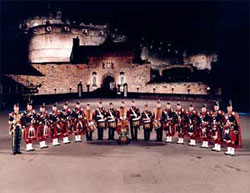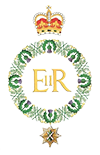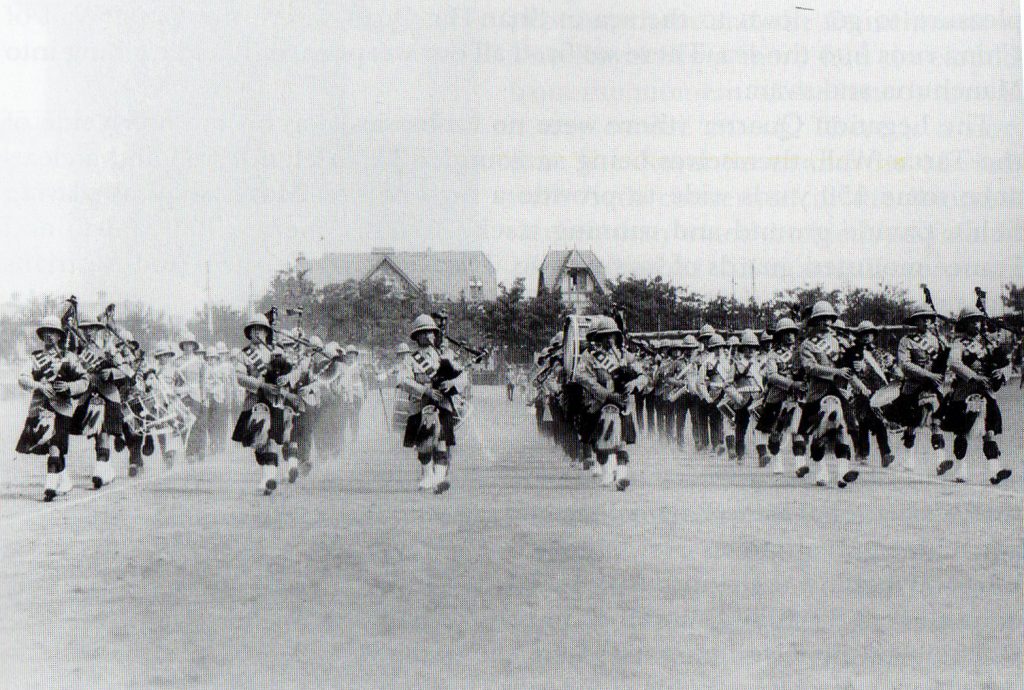On 30th June, 1667 Samuel Pepys met Lord George Douglas in Rochester and mentions seeing his Regiment; he records that “here in the streets I did hear the Scotch March beat by the drums before the soldiers, which is very odde.”

Regimental Music is a specialised and detailed subject with a history of its own. This short essay can only outline the story behind its development, concentrating on the Bands rather than the music they played. For a more detailed study of the latter a student should consult the Records of The Royal Scots (The Royal Regiment) published in Dublin in 1915 and turn to Appendix 3, Regimental Music, compiled by A W Ingles, or Appendix 4, The Pipers of the Regiment. Both Appendices can be requested, on payment of a small donation, from The Museum Office (contact details can be found in the Museum section). Another invaluable source of information is The History of British Military Bands Volume II (Guards and Infantry) by Gordon and Alwyn Turner, published by Spellmount Publishers, whom we thank for their permission to draw heavily on their work.
In Scotland the bagpipes had for centuries been the mainstay of military music, particularly in the Highlands. Contemporary reports from the 1630s mention a pipe band in Hepburn’s Regiment of some 36 musicians and refer also to ‘the Scotch March’ believed to be the forerunner of Dumbarton’s Drums, the Regimental Quick March, played later by the Pipe Band. In 1679, having returned to England from France, the Regiment was reported to consist of twenty-one companies each of which had two drummers; there was also a Drum Major and a Pipe Major, this latter suggesting the presence of pipers, perhaps drummers doubling-up. Certainly the painting of the destruction of the Mole at Tangier in 1684 shows four pipers on the Mole.
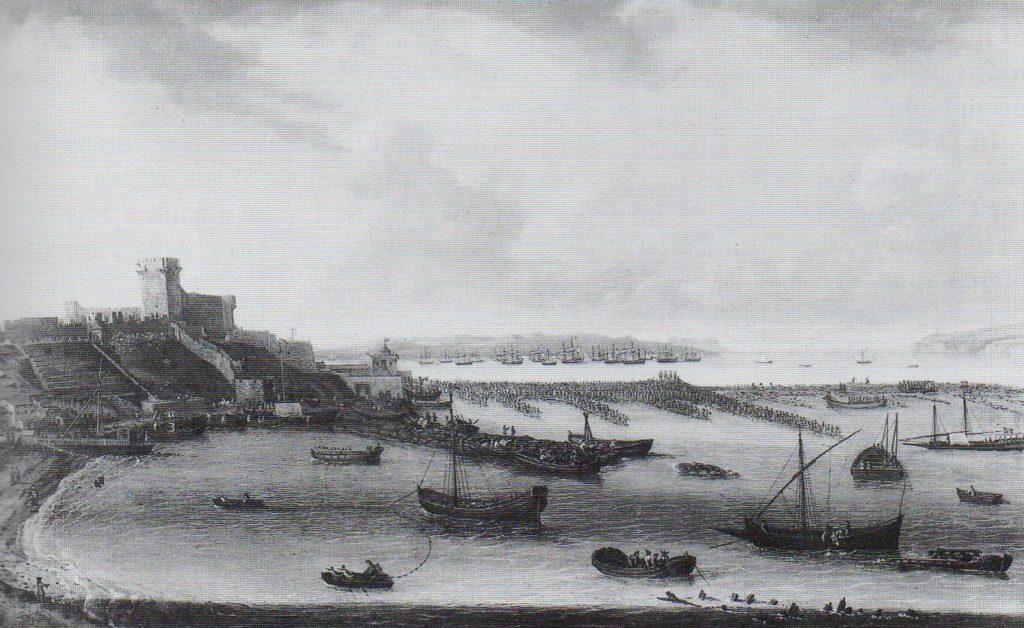
The Destruction of the Mole at Tangier, 1984, including the earliest known picture of military pipers, see enlargement below of the four figures in the center on the Mole.
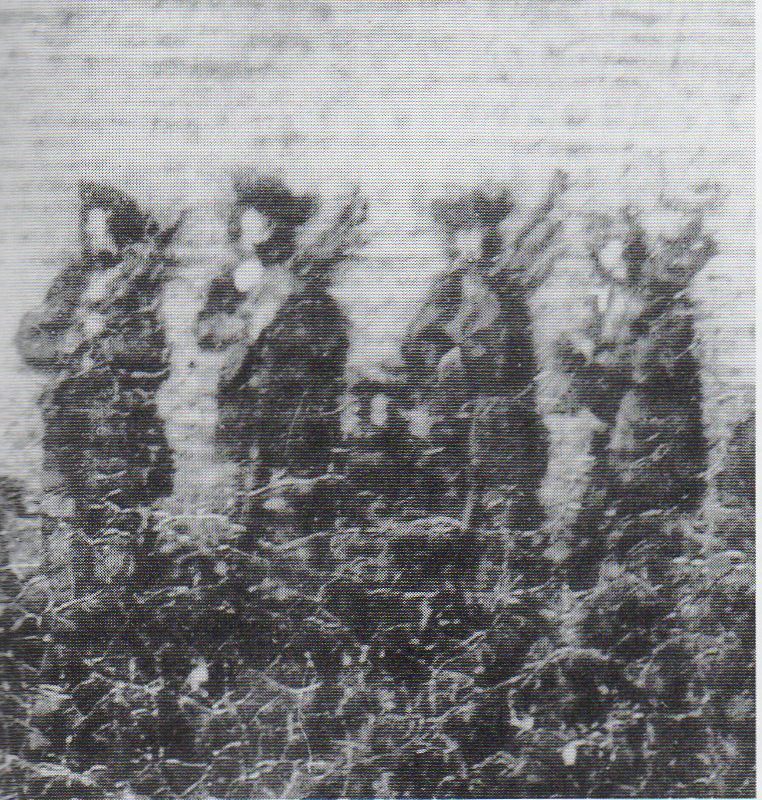
About the middle of the 18th Century, when the fife, as an instrument in military bands, had fallen more or less into disuse, the Duke of Cumberland began to interest himself in the improvement of regimental bands, and it was through his influence that measures were taken to have fifers placed on the establishment of each regiment or battalion. While they were referred to in an inspection report of 1767, it was not until 1769 that they were officially added to The Royal Scots, two being attached to each of the Grenadier Companies. The first reference to a military band is in General Dilkes’s inspection of the 1st Battalion at Dublin in 1767 when, in addition to mentioning the fifers, he referred to a ‘band of Musik’ The members of such a band at this time were civilian musicians engaged for the purpose, and paid by the Officers. By 1776 a report refers to ‘8 private soldiers acting as musicians’, and bands grew rapidly from then for, by 1800, there was a complaint that the Bands were ‘too large’. This probably resulted from the Army Authorities by this time bowing to change and formally allowing enlisted soldiers from the ranks to be employed as musicians, thereby replacing the previously privately-funded funded civilians. In 1809 the band of the 3rd Battalion (Special Reserve), then The Edinburgh Militia, consisted of five clarinets, two horns, one serpent (a bass wind instrument, usually classed as brass, and a distant musical relative to today’s tuba – but looking like a serpent!), six keyed flutes and three A fifes, bassoons etc, a total of seventeen instruments. By 1815 the 1st Battalion could produce twenty-two on parade although, by 1822, this was down to fifteen.

Bandsman, Private (Battalion Company) and Drummer (Grenadier Company), 1815
During WW1 the Bandmasters and band-boys remained at the Depot to form new bands whilst most of the bandsmen went on active service acting as stretcher bearers. This happened again in WW2 and many bandsmen of the 1st Battalion were lost in the withdrawal to Dunkirk. The Band of the 2nd Battalion suffered a similar fate in Hong Kong with the Bandmaster, Mr Jordan, being one of the first killed, on 10 December, and many others drowning in the sinking of the Lisbon Maru.
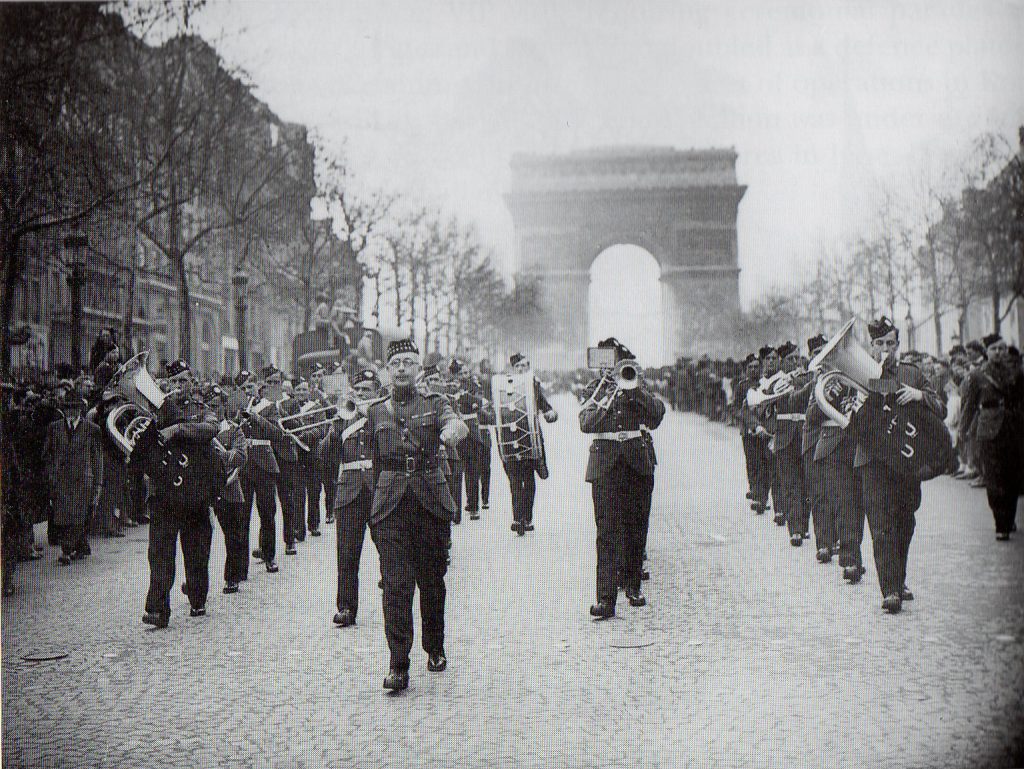
The Military Band at the Arc de Triomphe, Paris, March 1946
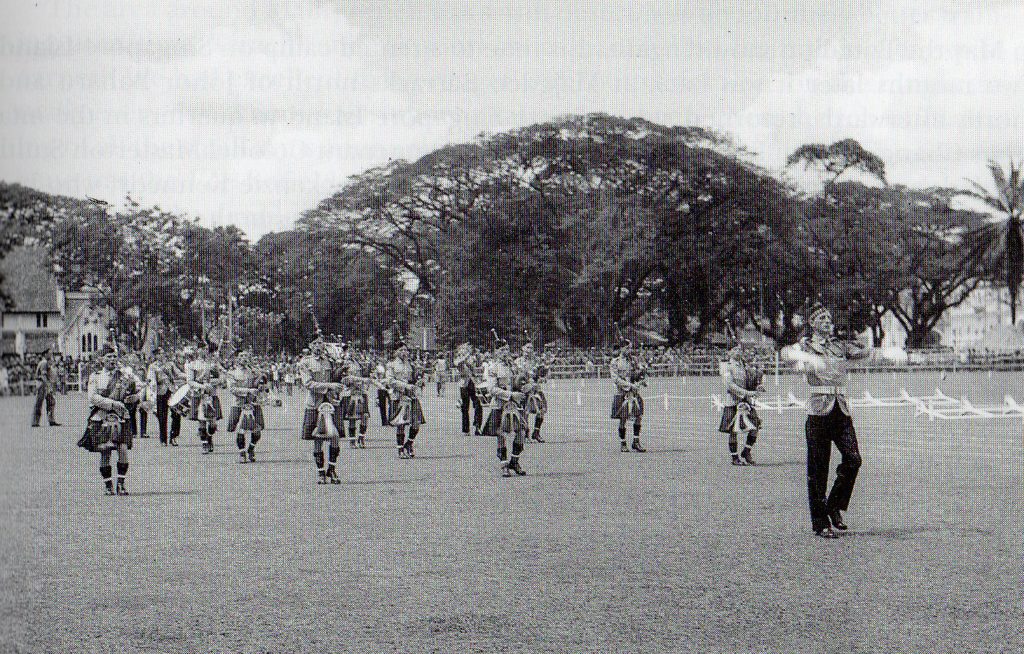
Pipes and Drums of the 1st Battalion playing at the opening of the Malaya Command Sports, Kuala Lumpur, March 1946
Both Regular bands were subsequently reformed but amalgamated, with their Battalions, in 1948. Thereafter the Band accompanied the 1st Battalion on many of its overseas tours, and exercises often serving operationally as infantrymen when required. By 1994 the strength of the band had fallen to only 15 and, on 15 March, as part of the Options for Change, it amalgamated with the Military Bands of the other Lowland Regiments to form a thirty-five strong staff band, The Lowland Band of The Scottish Division, which wore the Government Tartan. The Hunting Stuart lived on, however, in the The 52nd Lowland Brigade Band, which was formed in 1999 from the former Royal Scots Territorial Band which, until then, had carried on the long tradition of Volunteer or Territorial battalion bands since the mention of the Edinburgh Militia Band in 1809.
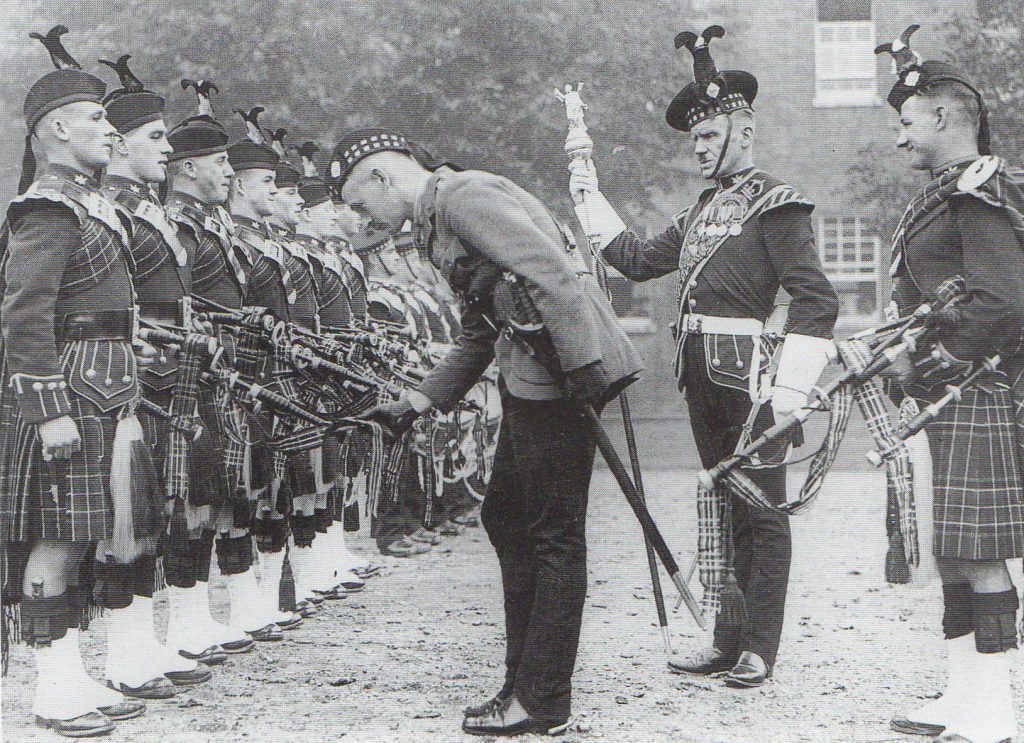
Lieutenant A G Mackenzie-Kennedy, Adjutant inspecting the Royal Stuart tartan granted to the pipers as a personal distinction by HM King George V on the occasion of his visit for the Tercentenary, 19 April 1933. The Drum Major is carrying "Big Andy" the Regimental Mace (see the essay on Regimental Silver).
Pipes and Drums continued as part of the 1st Battalion with members required to be fully-trained fighting soldiers as well as competent musicians. Their establishment in 2000 was one Drum Major, one Pipe Major, a Pipe Sergeant, fourteen pipers and six drummers.
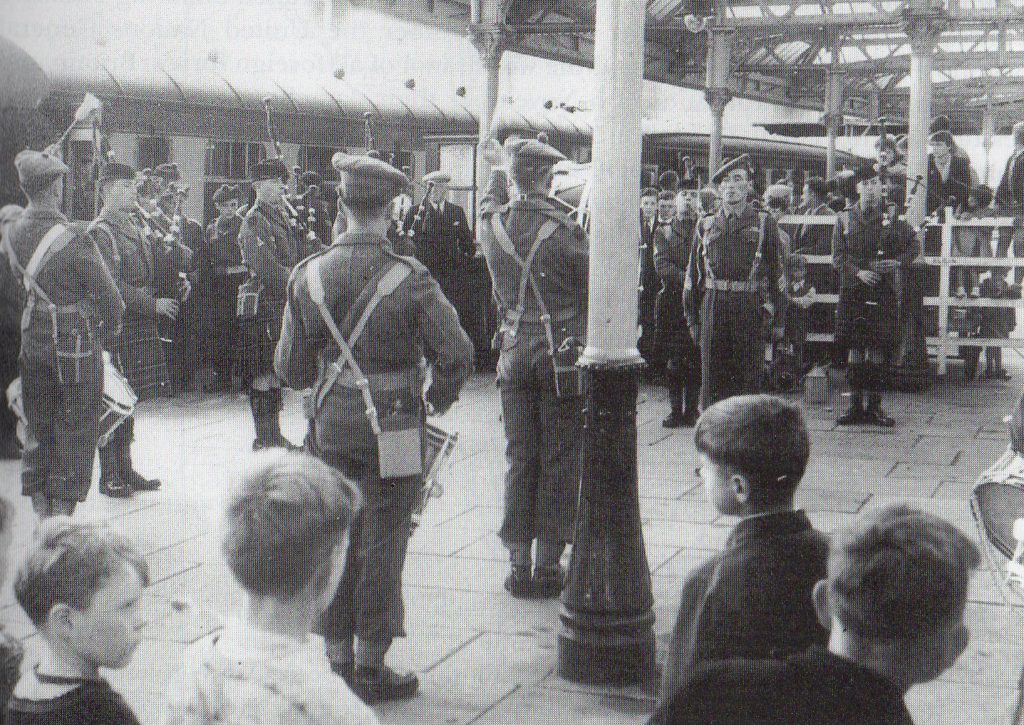
The Pipes and Drums playing at Elgin Station as the 1st Battalion entrains at the start of the Suez Operation, 12 August 1956
Both Bands made many European and further overseas tours including, for the Pipes and Drums, to South America and Australia in 1964 and to North America in 1972 and 1975. Both Bands also made a number of recordings.
The Regimental Music which was in use until 2006 is shown below. A comparison with that played a hundred years before shows little change. Such changes that there were reflected the amalgamation of the 1stand 2nd Battalions in 1948, while the Retreat March records the distinguished part played by the 1st Battalion in the Battle for Kohima in 1944. A book of Regimental Pipe Music was published in 1981 which gives the definitive settings of the Regimental pipe tunes and calls as well as including a large number of other tunes composed by members of the Regiment over the years (The Royal Scots Book of Pipe Music published by Novello and Co Ltd). In 1983 , to mark the 350th Anniversary of the Regiment, the then Pipe Major Clarke composed the tune The Reel of The Royal Scots and it was set to dance by The Royal Scottish Country Dance Society. It was first performed in public at The Edinburgh Military Tattoo that year.

REGIMENTAL MARCHES AND PARADE MUSIC
| Regimental Quick March | Dumbarton’s Drums |
| Regimental Quick March | Daughter of The Regiment * |
| Regimental Slow March | In the Garb of Old Gaul |
| March On | Scotland the Brave |
| Royal Salute | Point of War |
| General Salute | Loch Leven Castle |
| Advance in Review Order | Scotland the Brave |
| March Off | Blue Bonnets |
| Regimental Charge | Monymusk |
| Officers’ Mess | HRH Princess Mary’s Wedding March |
| HRH The Princess Anne’s March |
* First played in 1889 by the Band of the 2nd Battalion as a compliment to Queen Victoria when she took the salute at a Review in Aldershot. Her father, The Duke of Kent, was Colonel of the Regiment when she was born. The tune comes from an opera of the same name by Donnizetti and is the melody of a song sung by the heroine, Marie, to the soldiers - ‘Quel Regiment!’ - ‘What a Regiment!’. It was played as a Regimental March whenever Royalty were on parade and when the Military Band played off after a Band Programme, following after Dumbarton’s Drums.
COMPANY MARCHES
| A Company | The Barren Rocks of Aden |
| B Company | Mhairi’s Wedding |
| C Company | The Black Bear |
| D Company | The Liberton Polka |
| HQ Company | The Steamboat |
The bands of the 2nd Battalion playing in Tientsin, China 1929
REGIMENTAL CALLS AND WARNINGS
| Reveille | Johnnie Cope |
| Breakfast | Bundle and Go |
| Commanding Officer’s Orders | A Man’s a Man for a’ That |
| Dinner | Brose and Butter |
| Half Hour Dress | Up and Warn them a’ Wullie |
| Tea | Jenny’s Bawbee |
| Retreat | The Heroes of Kohima |
| First Post | The Battle of Killiecrankie |
| Last Post | Lochaber no More |
| Lights Out | Sleep, Dearie Sleep |
| 1st Officers’ Mess | Bannocks of Barley Meal |
| 2nd Officers’ Mess | Pibroch o’ Donald Dhu |
Pipe Major Marr and Drum Major Gorrie, at the Edinburgh Tattoo
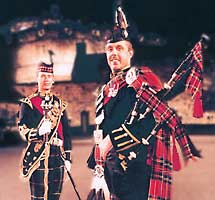
Edinburgh Castle
